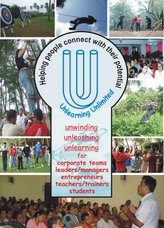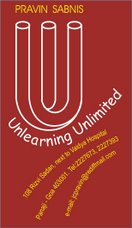Monday, July 25, 2011
HUMAN PLANK
Many from my tribe of trainers are attracted by the skill of magic and its ability to impress the learners as a tool that intrigues as well as excites the participants at a training workshop. However, while most would reveal the logic behind the magic, there are a few who indulge in deceit by claiming that the trick is based on some special powers of hypnosis.
One such trick is the ‘human plank’. The act involves making a subject lie horizontally between two chairs, making the body rigid and making another volunteer stand upon that person for dramatic effect. Actually the trick requires no hypnosis... rather it depends on the fact that when the subjects are positioned in the appropriate manner, they can support more weight than it may seem possible to the audience.
While it is good for educators to use the magicians’ trick as an activity to aid esteem building, it would be better if we shun the temptation to betray the trust that learners invest in us. The plank of trust between the learner and the teacher should not be built on consciously conceived irrational interpretations of what is a perfectly logical phenomenon. Persons who betray the trust deserve to be exposed for their deceit.
Let’s BE BETTER at honouring the trust learners invest in us
The human plank is a logical possibility, not hypnosis fuss!
- Pravin K. Sabnis
Musings conceived while in Kerala, India.
Monday, July 18, 2011
GIGO
In the late 1990’s, while conducting training workshops for teams from the IT industry, I learnt a great deal from them about using the computer and the internet. Additionally, I also learnt of the unravelling of their vocabulary of abbreviations. One such term was GIGO - Garbage In, Garbage Out!
The phrase was used to point out that computers mechanically process the most ridiculous of input data (garbage in) and produce nonsensical output (garbage out). The term was most popular in the early days of computing, but applies even more today, when even impressive computers spew out loads of erroneous information in a short time.
GIGO is also used to describe failures in human decision making due to faulty, incomplete, or imprecise data. We involve in a tendency to put excessive trust in information on the internet. If we allow ourselves to blindly accept unsubstantiated information, surely we will spew out similar nonsense. We need to apply our critical thinking at all times to be better at ensuring that we do not suffer the GIGO syndrome... or change the context to Good In, Good Out!
‘Garbage in, Garbage out’ is a regressive inclination...
Let’s BE BETTER at the critically thoughtful actions!
- Pravin K. Sabnis
Monday, July 11, 2011
LET GO!
A wise man shared a funny incident with his audience. Everyone almost split their sides with laughter. Strangely he repeated the joke to the sound of restrained mirth. He kept cracking the same joke again and again till there was no laughter in the crowd. Then, with a smile he queried, ‘when you cannot laugh at the same joke over and over again, why do you keep crying over the same thing again and again?’
The above anecdote came to me through e-mail. Surely, we hold on too much to the negative incidents in our life. Even when the wound has healed, we still carry the pain. Life moves on but often we languish in travails gone by. We keep crying over the same thing again and again.
We need to draw inspiration from little children. They can laugh at the same joke again, yet they forget the unpleasant in a jiffy. But as we grow older we begin to let go of the joys and hold on to the sorrows. The past sadness is allowed to sour up the possibilities in the present and the opportunities in the tomorrows to come.
After all, it is said so well that it is futile to cry over spilt milk. It is best to let go of the past and the moments old. We need to shrug off the grip of discouragement that comes from being burdened by a bad experience. We must be better at celebrating the affirmative and overcoming the negative.
Let go of the sadness of moments old...
BE BETTER at casting a positive mould!
- Pravin K. Sabnis
Monday, July 4, 2011
LET EAT!
In my tribe of trainers, traditional techniques employ the revealing theory which is often followed by justifications to underline the importance and relevance of the revealed information. However it is pertinent to note that most effective method that meshes better with how the brain works and assimilates information, is to introduce information through what is described as the EAT theory.
The acronym EAT refers to the three-stepped formula of Experience, Awareness and Theory. The approach starts with the learner going through an actual experience or sharing learnings from an earlier experience. The second step includes debriefing and discussion to bring about an Awareness of what they experienced. Lastly to tie up loose ends, the trainer confirms the Theory is confirmed in its entirety.
The reverse process singularly focuses only on explaining the theory. Information is passed on but the probability of real transfer of knowledge is at a huge disadvantage. After all, all information that is not understood by the recipient is in vain. On the other hand, experiential learning draws its vision from the maxim that ‘lessons are not meant to be taught… they are meant to be learnt.’
The same principle is applicable to teachers and other educators as well. In fact, it is all about freeing the learners’ mind and helping it embark on a dynamic journey of observation, thinking and interaction. Surely we can be better off at facilitating learning if we allowing learners to EAT with an open mind!
Why force feed and fetter learners’ feet...
BE BETTER at letting them freely EAT!
- Pravin K. Sabnis



